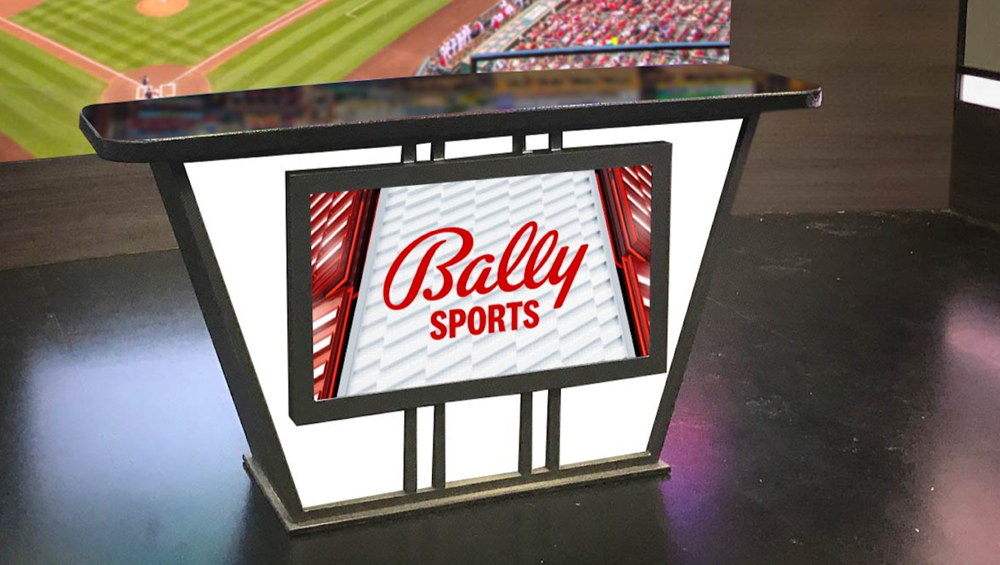
Sinclair Eyes Cost-Effective UHD Conversion Solution

Television stations and cable networks have lagged well behind streaming services like Netflix and Amazon Prime Video in offering Ultra High Definition (UHD) content, including the 4K and 1080-line-progressive with high dynamic range (1080p HDR) formats, to consumers and their 4K-capable smart TVs.
Major broadcast networks like Fox, NBC and CBS have delivered a smattering of 4K sports content through pay TV partners like DirecTV or their own apps, and new streaming services like Paramount+ are helping to close the gap by offering some UHD episodic content. But mainstream distribution for all broadcast and cable networks today remains in either 720p or 1080-line interlace (1080i), the two HD formats ratified under the ATSC 1.0 standard over 25 years ago.
That prevailing status quo is being pressured by the steady encroachment of UHD-capable streamers into major league sports programming, such as Amazon’s new deal to exclusively carry NFL games on Thursday nights this fall and Apple’s launch of MLB coverage on Fridays last month. And with the rollout of the new ATSC 3.0, or “NextGen TV,” standard underway, call-letter stations now have a means to directly deliver UHD programming to viewers — either over the air or over-the-top (OTT) through their own broadcast apps.
Impediments And Solutions
The biggest impediment to filling that new pipe with UHD content is the cost of upgrading existing production facilities, broadcast centers and distribution chains to shoot and transmit in UHD while still maintaining the current HD distribution. But Sinclair Broadcast Group thinks it has found a cost-effective solution in conversion technology that can take standard-dynamic range (SDR) content and transform it to high-dynamic range (HDR) content in real-time, a similar concept to the SD-to-HD upconverters that were heavily used in the early days of the HD migration.
And it says it can apply the same “Advanced HDR by Technicolor” technology across both its 185 broadcast stations as well as its cable properties, which include the Bally Sports regional sports networks, Marquee Network and Tennis Channel, to serve both HDR and SDR TV sets from a single 1080p HDR program stream.
While Sinclair has been a loud proponent of stations moving to the 3.0 standard, it hasn’t been as bullish on 4K, citing the significant costs of producing in and distributing a format that starts at 12 gigabits per second uncompressed. Instead, Sinclair, along with many other broadcasters, has pointed to the practical benefits of 1080p HDR, which represents a significant visual upgrade over 720p or 1080i SDR but can still be supported by much of the existing production chain, including legacy 3-gigabit HD-SDI routing infrastructures.
And on the transmission end for ATSC 3.0 or OTT distribution, 1080p HDR can be delivered at a much lower data rate, requiring around 8 Mbps with HEVC encoding compared to 15 Mbps or more for 4K.
Sinclair is already offering upconverted 1080p HDR at 28 of its 3.0 stations that are on-air today and aims to have 40 on-air with the format by year-end (it has more 3.0 stations on-air overall but isn’t able to offer the format in some markets where it is being hosted by another 3.0 station). None of those stations are currently producing native 1080p HDR.
Sinclair Ramps Up HDR
And at last month’s NAB Show, the company announced it will be stepping up its HDR efforts significantly by delivering HDR across its Bally Sports RSNs beginning in the third quarter of 2022. It will start with Bally Sports+, the direct-to-consumer streaming platform slated to launch in June, with hopes to eventually secure cable distribution to HDR-capable set-tops.

Mark Aitken
“We’re continuing the push to make sure that there is HDR content in the marketplace, because HDR content does differentiate content by quality,” said Mark Aitken, SVP of advanced technology, Sinclair Broadcast Group, at the show.
To do so, Sinclair is relying on the Advanced HDR by Technicolor technology, which is formally known as SL-HDR1 within the ATSC 3.0 standard and represents a technology partnership between Technicolor, Philips and InterDigital. SL-HDR1 uses a machine-learning technology called “Intelligent Tone Management” to dynamically upconvert SDR content to HDR, adjusting the brightness, contrast and color saturation on a frame-by-frame basis. It can be used to convert an entire production from SDR to HDR, or to simply upconvert SDR camera sources in a mixed SDR/HDR production. Or it can take a native HDR production and downconvert it to SDR for distribution to legacy sets.
To perform the actual SDR-to-HDR conversion today, Sinclair is relying on a modular product from Cobalt Digital, the 9904-UDX-4K up/down/cross converter, which Cobalt Digital SVP of Sales and Marketing Suzana Brady called the “Swiss Army Knife” of the company’s product line. “It’s a super-advanced processor that basically does every capability that Cobalt ever developed,” Brady said.

Cobalt Digital’s 9904-UDX-42 SDR/HDR cross-converter
Cobalt began working with SL-HDR1 over three years ago, and at the NAB Show was demonstrating a significant new “round-trip” capability for converting content from SDR to HDR and then back to SDR again with no discernible difference between the original and end SDR products. The new process, which Brady referred to as R-ITM, or “reversible inverse tone mapping,” means a big improvement in quality for SDR viewers over the first downconversions, where viewers might have noticed a difference from the original such as the red in a Coca-Cola can being slightly off-hue.
“If you have an HDR display, you’re going to see the full enhancements, the full color, the brightness, everything,” Brady said. “But if you have an SDR display you’re going to get the exact same original content, which is a big deal.”

Suzana Brady
The “round-trip” technology will allow Sinclair to cost-effectively roll out more HDR in a gradual way without harming existing SDR viewers, by sending a single SDR stream with additional HDR metadata in the form of supplemental enhancement information (SEI) messages. The additional metadata is a very small payload, representing tens of kilobits. An SL-HDR1-capable set can use it to reconstruct HDR, while an SDR set will simply ignore it and its picture will exactly match the original content.

Alan Stein
“The accuracy of the conversions is a critical step in preserving creative intent and not getting difficulties in the business deals,” said InterDigital VP of Technology Alan Stein. “That’s what makes this solution stand out and address a really important business need.”
Sinclair’s Demo
In its demonstration at the Wynn hotel in Las Vegas, Sinclair emulated live feeds of its RSNs by sending several different feeds over the Internet from a server at its Hunt Valley, Md., headquarters and presenting them on consumer TVs. The reason for doing that instead of live feeds from the Bally Sports NOC in Atlanta was so that it could show the exact same content on each screen for comparison, explained Matthew Goldman, senior director, media engineering & architecture for Sinclair.
The content was a montage of Tennis Channel footage, some drone footage of the FTX Arena in Miami, and some National Basketball Association content.

Matthew Goldman
“Just like we did over 20 years ago when there was not enough HD material and we were doing upconversions of SD to HD, this is the same type of thing,” Goldman said. “A lot of material we already have captured lends itself well to having an expanded color volume. It lends itself well to having higher contrast, where you keep the midtones, like your facetones, stable at an average level, and take the specular highlights and move them higher, because TV naturally compresses dynamic range.
“What we’re watching on TV today doesn’t look like what you’re watching at a game,” he continued. “The bright stuff is darker, and the dark stuff is brighter on a TV. So, you’re losing all the texture details in the dark area, and the same thing with the highlights. You don’t feel like you’re there.”
One TV showed the 1080p SDR production output from a standard truck, sent at a mezzanine rate of about 20 Mbps. The next screen showed the same content having been run through the SL-HDR1 upconversion and downconversion process, compressed for streaming distribution and displayed in SDR on a consumer set. The third TV showed the same feed having been converted to HDR and displayed on a consumer set. And the fourth showed another mezzanine-level production output, with an SDR feed inverse-tone mapped to HDR for mixing with native HDR content.
To the Sinclair team’s point, there was no visible differences in hues between the original SDR feed and the “round-tripped” content.
Sinclair’s Caveat
The one big caveat to the Sinclair strategy is that not all HDR-capable TV sets currently include an SL-HDR1 decoder. While LG originally incorporated the Technicolor technology into its sets, it now supports Dolby Vision as its preferred dynamic-metadata HDR format, as does Sony. Samsung sets currently support HDR10 and the HDR10+ format, but neither Dolby Vision nor SL-HDR1.
So far, Hisense is the one manufacturer that publicly supports SL-HDR1. Sinclair used some LG sets in its Wynn demo that Aitken said it was able to make work with a firmware update, and he believes the same update could be feasible with other sets.

Tony Bozzini
Tony Bozzini, head of business development for Advanced HDR by Technicolor, expects to “see a host of major manufacturers” support SL-HDR1 in 2023 thanks to the push from Sinclair and other programmers.
“Over the course of the next year and tail part of this year, you’re going to see a number of major manufacturers introduce, and in some cases reintroduce, Advanced HDR by Technicolor,” Bozzini said.

Hugo Gaggioni
Hugo Gaggioni, CTO of imaging products and solutions, Americas professional group for Sony Electronics, said he had seen strong interest from major networks in producing more HDR. He said NBC’s recent Olympics broadcasts were a key example, and that CBS and ESPN were also pursuing HDR. But he was skeptical about the SL-HDR1 approach to generating HDR content. And he said adding the decoder technology could represent a significant license expense for set makers, similar to Dolby Vision today.
“There’s no free lunch,” Gaggioni said. “This decoder is not free.”
































Comments (0)